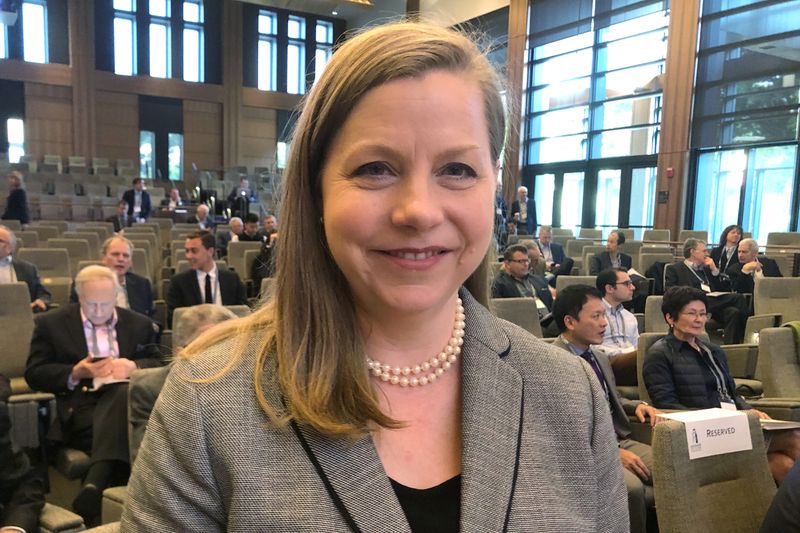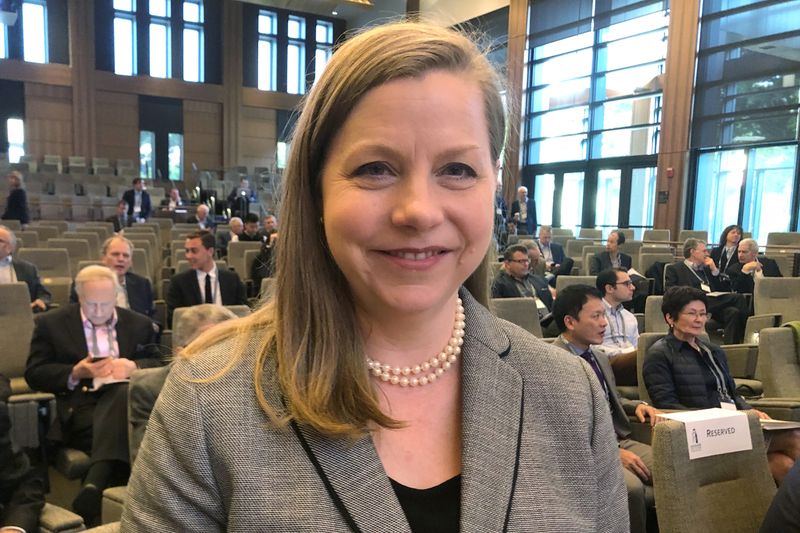Economy
Fed officials sketch case on both sides of rate debate


© Reuters. FILE PHOTO: U.S. Federal Reserve Governor Michelle Bowman poses at a conference on monetary policy at The Hoover Institution in Palo Alto, California, U.S., May 3, 2019. REUTES/Ann Saphir/File Photo
(Reuters) -The contours of the debate at the heart of the Federal Reserve’s policy decision next month came into clearer view on Monday as officials outlined the case for and against another interest rate hike.
“The debate is really about: Do we need to do another rate increase? Or not? … I think we’re pretty close to what a peak rate would be,” New York Fed President John Williams said in an interview with the New York Times in which he voiced some confidence that underlying inflation was on a downward path.
“I do think that we are moving to an environment already where the underlying inflation rate has come down quite a bit,” Williams said in the interview, conducted on Aug. 2 and released on Monday. Williams, the vice chair and a permanent voting member of the policy-setting Federal Open Market Committee, said that inflation measures developed by the New York Fed suggest the pace of price increases could slow to as little as 2.5% annually by the end of the year, within striking distance of the Fed’s 2% target.
In separate remarks to a “Fed Listens” community event in Atlanta, Fed Governor Michelle Bowman said the combination of still-elevated inflation and continued economic growth meant further rate increases are likely.
“I supported raising the federal funds rate at our July meeting, and I expect that additional increases will likely be needed to lower inflation to the (Federal Open Market Committee’s) goal,” she said, referring to the central bank’s benchmark overnight interest rate, which is currently set in the 5.25%-5.50% range.
“I will be looking for evidence that inflation is on a consistent and meaningful downward path as I consider whether further increases in the federal funds rate will be needed, and how long the federal funds rate will need to remain at a sufficiently restrictive level,” Bowman said.
The Fed’s preferred headline measure of inflation, the personal consumption expenditures price index, was at 3% on an annual basis as of June, while the same measure stripped of volatile food and energy prices was at 4.1% and has shown slower progress in recent months back to the Fed’s target.
The Fed raised rates by a quarter of a percentage point at the end of its July 25-26 meeting, and the most recent projections by policymakers show most expect one more rate increase by the end of the year.
But recent data have shown inflation slowing faster than expected, with many analysts anticipating a “disinflationary” trend may be developing that will work in the Fed’s favor.
Investors in contracts tied to the Fed’s policy rate are currently betting against any further increases, and expect the central bank’s next move to be a rate cut in the first months of next year.
Williams said that if inflation does continue falling, rate reductions would be appropriate next year so that the inflation-adjusted “real” rate of interest doesn’t increase through inaction.
“Assuming inflation continues to come down … then if we don’t cut interest rates at some point next year, then real interest rates will go up, and up, and up. And that won’t be consistent with our goals,” Williams said. “From my perspective, to keep maintaining a restrictive stance may very well involve cutting the federal funds rate next year.”
Economy
Russian central bank says it needs months to make sure CPI falling before rate cuts -RBC


© Reuters. Russian Central Bank Governor Elvira Nabiullina attends a news conference in Moscow, Russia June 14, 2019. REUTERS/Shamil Zhumatov/File Photo
MOSCOW (Reuters) – Russia’s central bank will need two to three months to make sure that inflation is steadily declining before taking any decision on interest rate cuts, the bank’s governor Elvira Nabiullina told RBC media on Sunday.
The central bank raised its key interest rate by 100 basis points to 16% earlier in December, hiking for the fifth consecutive meeting in response to stubborn inflation, and suggested that its tightening cycle was nearly over.
Nabiullina said it was not yet clear when exactly the regulator would start cutting rates, however.
“We really need to make sure that inflation is steadily decreasing, that these are not one-off factors that can affect the rate of price growth in a particular month,” she said.
Nabiullina said the bank was taking into account a wide range of indicators but primarily those that “characterize the stability of inflation”.
“This will take two or three months or more – it depends on how much the wide range of indicators that characterize sustainable inflation declines,” she said.
The bank will next convene to set its benchmark rate on Feb. 16.
The governor also said the bank should have started monetary policy tightening earlier than in July, when it embarked on the rate-hiking cycle.
Economy
China identifies second set of projects in $140 billion spending plan


© Reuters. FILE PHOTO: Workers walk past an under-construction area with completed office towers in the background, in Shenzhen’s Qianhai new district, Guangdong province, China August 25, 2023. REUTERS/David Kirton/File Photo
SHANGHAI (Reuters) – China’s top planning body said on Saturday it had identified a second batch of public investment projects, including flood control and disaster relief programmes, under a bond issuance and investment plan announced in October to boost the economy.
With the latest tranche, China has now earmarked more than 800 billion yuan of its 1 trillion yuan ($140 billion) in additional government bond issuance in the fourth quarter, as it focuses on fiscal steps to shore up the flagging economy.
The National Development and Reform Commission (NDRC) said in a statement on Saturday it had identified 9,600 projects with planned investment of more than 560 billion yuan.
China’s economy, the world’s second largest, is struggling to regain its footing post-COVID-19 as policymakers grapple with tepid consumer demand, weak exports, falling foreign investment and a deepening real estate crisis.
The 1 trillion yuan in additional bond issuance will widen China’s 2023 budget deficit ratio to around 3.8 percent from 3 percent, the state-run Xinhua news agency has said.
“Construction of the projects will improve China’s flood control system, emergency response mechanism and disaster relief capabilities, and better protect people’s lives and property, so it is very significant,” the NDRC said.
The agency said it will coordinate with other government bodies to make sure that funds are allocated speedily for investment and that high standards of quality are maintained in project construction.
($1 = 7.1315 renminbi)
Economy
Russian central bank says it needs months to make sure CPI falling before rate cuts -RBC


© Reuters. Russian Central Bank Governor Elvira Nabiullina attends a news conference in Moscow, Russia June 14, 2019. REUTERS/Shamil Zhumatov/File Photo
MOSCOW (Reuters) – Russia’s central bank will need two to three months to make sure that inflation is steadily declining before taking any decision on interest rate cuts, the bank’s governor Elvira Nabiullina told RBC media on Sunday.
The central bank raised its key interest rate by 100 basis points to 16% earlier in December, hiking for the fifth consecutive meeting in response to stubborn inflation, and suggested that its tightening cycle was nearly over.
Nabiullina said it was not yet clear when exactly the regulator would start cutting rates, however.
“We really need to make sure that inflation is steadily decreasing, that these are not one-off factors that can affect the rate of price growth in a particular month,” she said.
Nabiullina said the bank was taking into account a wide range of indicators but primarily those that “characterize the stability of inflation”.
“This will take two or three months or more – it depends on how much the wide range of indicators that characterize sustainable inflation declines,” she said.
The bank will next convene to set its benchmark rate on Feb. 16.
The governor also said the bank should have started monetary policy tightening earlier than in July, when it embarked on the rate-hiking cycle.

 Forex2 years ago
Forex2 years agoForex Today: the dollar is gaining strength amid gloomy sentiment at the start of the Fed’s week

 Forex2 years ago
Forex2 years agoHow is the Australian dollar doing today?

 Forex1 year ago
Forex1 year agoUnbiased review of Pocket Option broker

 Forex2 years ago
Forex2 years agoDollar to pound sterling exchange rate today: Pound plummeted to its lowest since 1985

 Cryptocurrency2 years ago
Cryptocurrency2 years agoWhat happened in the crypto market – current events today

 World2 years ago
World2 years agoWhy are modern video games an art form?

 Stock Markets2 years ago
Stock Markets2 years agoMorgan Stanley: bear market rally to continue

 Economy2 years ago
Economy2 years agoCrude oil tankers double in price due to EU anti-Russian sanctions

































